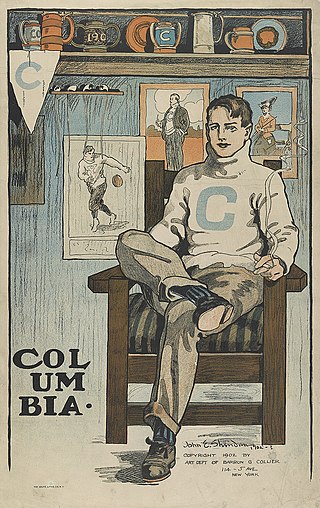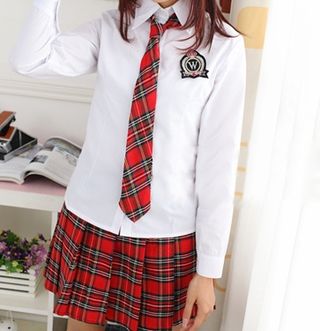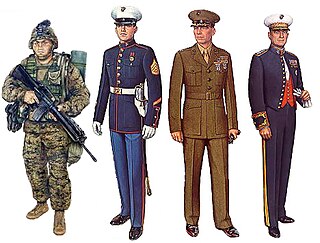
The Japanese school uniform is modeled in appearance similar to that of the European-style naval uniforms. It was first used in Japan in the late 19th century, replacing the traditional kimono. Today, school uniforms are common in many of the Japanese public and private school systems. The Japanese word for this type of uniform is seifuku (制服).

Preppy, or prep, is an American subculture associated with the alumni of college-preparatory schools in the Northeastern United States. The term, which is an abbreviation of "preparatory", is used to denote a person seen as characteristic of a student or alumnus of these schools. Characteristics of preppy individuals include a particular subcultural speech, vocabulary, dress, mannerisms and etiquette reflective of an upper class and old money upbringing.

A suit, lounge suit, or business suit is a set of clothes comprising a suit jacket and trousers of identical textiles generally worn with a collared dress shirt, necktie, and dress shoes. A skirt suit is similar, but with a matching skirt instead of trousers. It is currently considered semi-formal wear or business wear in contemporary Western dress codes, however when the suit was originally developed it was considered an informal or more casual option compared to the prevailing clothing standards of aristocrats and businessmen. The lounge suit originated in 19th-century Britain as sportswear and British country clothing, which is why it was seen as more casual than citywear at that time, with the roots of the suit coming from early modern Western Europe formal court or military clothes. After replacing the black frock coat in the early 20th century as regular daywear, a sober one-coloured suit became known as a lounge suit.

A blouse is a loose-fitting upper garment that may be worn by workmen, peasants, artists, women, and children. It is typically gathered at the waist or hips so that it hangs loosely ("blouses") over the wearer's body. Today, the word most commonly refers to a girl's or woman's dress shirt, although there is considerable confusion between a true blouse and a women's shirt. It can also refer to a man's shirt if it is a loose-fitting style, though it rarely is. Traditionally, the term has been used to refer to a shirt which blouses out or has an unmistakably feminine appearance, although even many "standard" shirts today have a somewhat blousy fit, and the numbers of men wearing such shirts may match that of women wearing actual blouses.

Fashion in the 1890s in Western countries is characterized by long elegant lines, tall collars, and the rise of sportswear. It was an era of great dress reforms led by the invention of the drop-frame safety bicycle, which allowed women the opportunity to ride bicycles more comfortably, and therefore, created the need for appropriate clothing.

A Catholic school uniform in North America typically consists of a pleated and tartan skirt or jumper dress, Mary Jane or saddle shoes, a button-down shirt, and a sweater for girls, while boys' uniforms consist of a button-down shirt, a necktie, and dark pants. Actual school uniforms vary widely by location and individual school.

Casual wear is a Western dress code that is relaxed, occasional, spontaneous and suited for everyday use. Casual wear became popular in the Western world following the counterculture of the 1960s. When emphasising casual wear's comfort, it may be referred to as leisurewear or loungewear.

Fashion in the 1990s was defined by a return to minimalist fashion, in contrast to the more elaborate and flashy trends of the 1980s. One notable shift was the mainstream adoption of tattoos, body piercings aside from ear piercing and, to a much lesser extent, other forms of body modification such as branding.

Smart casual is an ambiguously defined Western dress code that is generally considered casual wear but with smart components of a proper lounge suit from traditional informal wear. For men, this interpretation typically includes dress shirt, necktie, trousers, and dress shoes, possibly worn with an odd-coloured blazer or a sports coat.

The uniforms of the United States Navy include dress uniforms, daily service uniforms, working uniforms, and uniforms for special situations, which have varied throughout the history of the navy. For simplicity in this article, officers refers to both commissioned officers and warrant officers.

Fashion in the years following World War II is characterized by the resurgence of haute couture after the austerity of the war years. Square shoulders and short skirts were replaced by the soft femininity of Christian Dior's "New Look" silhouette, with its sweeping longer skirts, fitted waist, and rounded shoulders, which in turn gave way to an unfitted, structural look in the later 1950s.

Service dress uniform is the informal type of uniform used by military, police, fire and other public uniformed services for everyday office, barracks and non-field duty purposes and sometimes for ceremonial occasions. It frequently consists of a jacket, trousers, dress shirt, and neck tie, along with orders, medals, and insignia. Design may depend on regiment or service branch, e.g. army, navy, air force, marines, etc. In Western dress codes, a service dress uniform is a permitted supplementary alternative equivalent to the civilian suit - sometimes collectively called undress or "dress clothes". As such, a service dress uniform is considered less formal than both full dress and mess dress uniforms, but more formal than combat uniforms.

The Army Service Uniform (ASU) is a military uniform for wear by United States Army personnel in garrison posts and at most public functions where the Army Combat Uniform is inappropriate. As of 2021, the Army has two service uniforms for use by its personnel. The Army Green Service Uniform, announced in 2018 and authorized in 2020, is used primarily for daily use in situations where civilians wear business attire, such as office settings or official meetings.

The United States Marine Corps (USMC) prescribes several types of military uniform to distinguish its service members from other armed services, depending on the situation.

Informal wear or undress, also called business wear, corporate/office wear, tenue de ville or dress clothes, is a Western dress code for clothing defined by a business suit for men, and cocktail dress or pant suit for women. On the scale of formality, it is considered less formal than semi-formal wear but more formal than casual wear. Informal or undress should not be confused with casual wear such as business casual or smart casual; most situations calling for “informal wear” will usually tolerate casual dress to varying extents.

Fashion in the period 1900–1909 in the Western world continued the severe, long and elegant lines of the late 1890s. Tall, stiff collars characterize the period, as do women's broad hats and full "Gibson Girl" hairstyles. A new, columnar silhouette introduced by the couturiers of Paris late in the decade signaled the approaching abandonment of the corset as an indispensable garment.
This is a list of existing articles related to fashion and clothing. For individual designers, see List of fashion designers

Ivy League is a style of men's dress, popular during the late 1950s in the Northeastern United States, and said to have originated on college campuses, particularly those of the Ivy League. It was the predecessor to the preppy style of dress.

School uniform is a practice that dates to the 16th century in England. Charity schools such Christ's Hospital, founded in 1552 in London, were among the first schools to use a uniform for their students. The earliest documented proof of institutionalised use of a standard academic dress dates back to 1222 when the Archbishop of Canterbury ordered wearing of the cappa clausa.

Fashion and clothing in the Philippines refers to the way the people of the Philippine society generally dress up at home, at work, travelling and during special occasions.




















